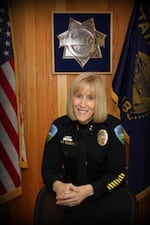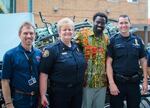
Janie Schutz
Women make up about
10 percent of the officers on police forces
around the country. And not much has changed, at least by the numbers, since
became the Portland Police Chief in 1985. She was the first woman in any major American city to do so. Harrington told
the 10 percent number is far too low.
"It's pretty depressing that it's dropped that much, because it used to be 14 to 16 percent," she said. "But I believe that the reason it's so low is that there's no political will, there's no pressure from the public, there's no reason to work at trying to work at getting women into policing."
The percentage of women in the Forest Grove Police Department is about double the national average. But that's something that chief of police Janie Schutz says is more by chance than by design.
"We do our best effort not to look for specifics, whether it's gender or race or whatnot. I would like to think everyone has an opportunity," she said. "If they want to be a police officer, we would encourage them to apply. But I am looking for the best fit for Forest Grove."
She says becoming a police officer is definitely challenging for women in a predominately male police culture. Schutz says before getting the chief job in Forest Grove, she came up the ranks in South Carolina.
"There definitely was a proving that had to be done. And yes I could hear a lot of sexual comments, whether it was directly related to me or just a bunch of men talking about something they had seen on television or a movie or something," she said. "I learned very quickly to let it just roll off."
Why Police Departments Should Want More Women
Assistant Chief of Police Donna Henderson is the highest ranking woman in the Portland Police Bureau. She says about 15 percent of Portland officers are women and those women bring something vital to policing.

Assistant Chief Donna Henderson
Portland Police Bureau
"There are some qualities that women officers bring to the profession that they're just more comfortable bringing," she said. "I think we bring to the forefront a little bit more compassion; we're more taught to listen, more than we're taught to talk; we're very relational; and we can relate to people very well."
Penny Harrington, who founded the National Center for Women in Policing, says police departments could cut down on use of force by hiring more women, since the evidence shows women are much less likely to use excessive force.
"What happens is that the female officer resorts to using her negotiation, mediation skills to defuse the situation. That's what they've shown in the studies that have been done," Harrington said. "If you can not get caught up in the acceleration of what's going on, and if you can be the calm cool head, and step in and try and deescalate the violence then you have a much better chance of getting things under control."
Harrington says unfortunately, a lot of officers have a hard time backing down.

Penny Harrington, the first woman to become chief of the Portland Police Bureau
Portland Police Museum and Historical Society
"And it's not that the women are afraid they can't handle themselves," she said. "Because they're taught how to; they know how to handle themselves. It's that they want to try and not have it escalate to that level."
Recruiting: Being At The Right Place, All The Time
Harrington says even if there is a conscious desire to hire more women, often police departments aren't focusing their recruiting in the right places.
"If you go to community colleges you're going to have a better chance of recruiting women than if you go to military bases," she said.
According to Harrington, it's possible to boost the number of women on police forces. Harrington cites as an example the work she did with the Los Angles PD after the Rodney King beatings and the riots that followed.
"So, they set a goal of 40 percent to get more women into policing," she said. "And everyone said, 'You can't do that. There's no way you can do that.' Well, I worked with them, and some other people worked with them. And the very first class they hired had 40 percent women and the second class they hired had 40 percent women."
She says part of the recruiting effort was a very simple ad, but one that reached a broad spectrum of women.
"We got the theaters to let the LAPD put a trailer up before the movies," Harrington said. "And it was just one picture of a woman officer sitting on a motorcycle with a big grin on her face and her thumb up in the air. And people would actually applaud when that came on, and the phones at the recruiting office would go crazy."
Henderson, Portland's assistant chief, agrees with the strategy of broad-based recruiting, but she says it's also about changing the internal culture. And that change is something she's seen firsthand in the Portland Police Bureau since she first joined the force in 1988.
